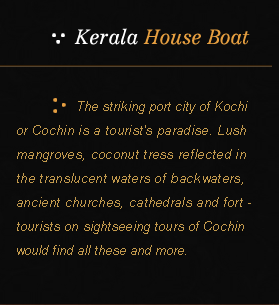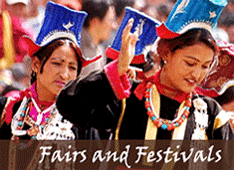Home > North India Tour Packages > Classical India with Backwaters

Duration : 16 Days & 15 Nights
Location : Delhi – Varanasi – Khajuraho – Gwalior – Agra – Jaipur – Cochin – Thekkady – Kumarakom – Alleppey – Cochin.
Location : Delhi – Varanasi – Khajuraho – Gwalior – Agra – Jaipur – Cochin – Thekkady – Kumarakom – Alleppey – Cochin.
Day 01
Delhi Arrival:
COMPANY REPRESENTATIVE will receive you on arrival at the DELHI AIRPORT and transfer to your hotel.
DELHI, the capital of kingdoms and empires is now a sprawling metropolis with a fascinating blend of the past and the present. It is a perfect introduction to the composite culture of an ancient land. A window to the kaleidoscope - that is India.
Overnight will be at Delhi.
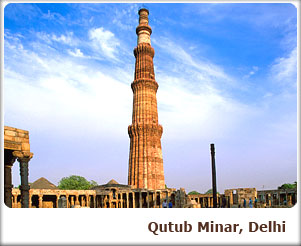 Day 02
Day 02
Delhi:
After breakfast proceed for a day sightseeing tour of the city.
The city is dotted with historic monuments that are the most popular tourist attractions in Delhi. Apart from the monuments, there are museums, markets, gardens and eating joints that you can visit on your tour of Delhi. Some of the important sightseeing places in Delhi are given below.
INDIA GATE: It is the war memorial dedicated to Indian soldiers, who died during World War I. The name of many soldiers who died during World War I is inscribed on its wall. Edward Lutyens, the man who planned and built New Delhi, designed India Gate. Almost every foreign tourist visits the monument. 'Amar Jawan Jyoti', the eternal flame is added later. The eternal flame runs on gas and is a tribute to soldiers who lost their lives in the service of the nation.
RED FORT: Located in Old Delhi, the Red Fort or Lal Quila is a popular tourist attraction in Delhi. The fort was built by the Mughal emperor Shah Jahan in 1648, when he moved his capital from Agra to Delhi. The construction of the Fort started in 1638 and it was completed 10 years later in 1648. Some of the important spots inside the Red Fort include royal baths or Shahi hamams, Shahi Burj, Moti Masjid or the Pearl Mosque, Diwan-e-Aam and Diwan-e-Khas.
JAMA MASJID: The largest mosque in India, the Jama Masjid was built by Shah Jahan 1656 AD. About 5,000 laborers and craftsmen worked for six years to complete the monument. The mosque can accommodate about 25,000 people. The mosque is located in the old Delhi. The domes are built in white marble. The prayer hall of the mosque has 260 pillars.
OLD FORT: Old Fort or Purana Quila as it is called is located near Pragati Maidan on the Mathura Road. You can club a visit to the Old Fort with your tour of Red Fort and Jama Masjid as the three monuments are located in Old Delhi and are not too far from one another. Humanyun’s started the construction of the fort in 1533 AD, but before the completion of the fort, Sher Shah Suri defeated him and captured Delhi. Sher Shah Suri completed the fort and named it -Shergah. He added many structures to the fort, of which Qila-I-Kuhna Mosque and Sher Mandal are worth mentioning. In 1555, Humanyun’s re-captured Delhi and converted Sher Mandal into a library.
HUMANYUN’S TOMB: Humanyun’s Tomb is mausoleum of the Mughal emperor Humanyun’s. Bega Begum also known as Haji Begum, wife of Humayun constructed the mausoleum for her husband. The tomb was built between 1562 and 1572 AD. The tomb was designed by Mirak Mirza Ghiyuth.
QUTAB MINAR: The construction of the Qutab Minar was stated by Qutub-ud-din Aibak in 1199 AD but he died before completing it. His son-in-law and successor Iltutmish completed the construction of the building. Qutab Minar is located in Meharauli.
LOTUS TEMPLE: Also known as the Bahai Temple, the monument was opened to public only in 1986. Located near Nehru Place, the Lotus Temple is designed like a lotus flower. If you are looking for some moments of peace and tranquility in the crowded city, Lotus Temple is the ideal place to visit.
Apart from the above-mentioned sightseeing options, there are various other tourist attractions that you can visit on your tour of Delhi. Some other sightseeing places in Delhi include Lodi Gardens, National Museum, Jantar Mantar, Dilli Haat and the Garden of Five Senses.
Overnight will be at Delhi.
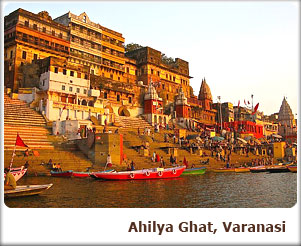 Day 03
Day 03
Delhi – Varanasi:
By Air
Breakfast will be at hotel.
Transfer in time to airport for flight to Varanasi. Upon arrival at Varanasi, you will be met and transferred to hotel.
Picturesquely situated on the crescent shaped left bank of the holy River Ganges, Varanasi, one of the ancient seats of learning in India, is said to be a compound of the names of two streams, the Varuna and the Assi, which still flow in the north and south of the city respectively. This name seems to have been corrupted, in medieval times to Varanasi, which was in use till May 1956, when it was changed to Varanasi, by an order of the Government of India. Varanasi is probably one of the most ancient living cities in India. From time immemorial it has been a great religious center for Hindus and one of their most sacred places of pilgrimage, being visited by millions of people every year. To every visitor Varanasi offers a breathtaking experience. The rays of the dawn shimmering across the Ganges; the high-banks; the temples and shrines along the banks bathed in a golden hue …soul stirring hymns and mantras along with the fragrance of incense filling the air…and the refreshing dip in the holy waters gently splashing at the Ghats. Varanasi – The land where experience and discovery reach the ultimate bliss. Varanasi is also renowned for its rich tapestry of music, arts, crafts and education. Some of the world – renowned exponents India has produced in these fields were schooled in Varanasi’s cultural ethos. Luminaries apart, Varanasi abounds in the art of silk weaving, an exotic work of art which manifests itself in precious Banarasi silk sarees and silk brocades which are cherished as collector’s items across the world today.
Enjoy the evening AARTI at the GHATS. The guide will be giving a commentary to you on the proceedings and meanings of the chants during the AARTI of the river.
Later spend the evening shopping in the lanes of Varanasi.
Overnight will be at Varanasi.
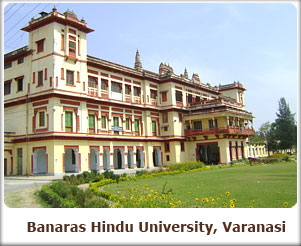 Day 04
Day 04
Varanasi:
Proceed in the morning to Daswamedh Ghat and take a boat ride on the sacred river Ganges to see the cremation Ghats and witness the living traditions of one of the world's oldest and most important religions.
Cruise the Ganges. Perhaps the best way to enjoy the site of Varanasi’s Ghats is a cruise along the river at dawn. Hundreds of bathers, worshippers performing religious rites, holy men practicing yoga and people washing clothes gather at the river’s banks. (To start at 0500 hrs. for the best lifetime experience) For you to appreciate this remarkable city, we’ll transfer you to the banks of the River Ganges before the sun rises. Board a boat with your guide and proceed to the middle of the river, where at sunrise the sight unfolds before you. Thousands of faithful come daily to the banks to bathe and pray while in the background, temples and palaces rise in tiers from the water’s edge. Return for a walk through the cobblestone streets along the banks of "Ganga". As shops are opening, the place now becomes a beehive of activity as the faithful are coming and going.
Return to hotel for a sumptuous breakfast.
Proceed for the sightseeing.
Bharat Mata Mandir: Bharat Mata Mandir or Bharat Mata Temple is one of its kinds in Varanasi. Contrary to what most of the tourists believe, this temple is not dedicated to any God, Goddess or certain deity for that matter. It is dedicated to the human manifestation of India popularly called Mother India or Bharat Mata in Hindi. The temple was inaugurated by non other than Mahatma Gandhi, The father of the Indian Nation.
Banaras Hindu University: BHU was built in the year 1916-1917 under the special act of parliament passed in the year 1915 named BHU act. The act was passed by the interim parliament that worked under the imperial British government. Mahamna Pundit Madan Mohan Malaviya and Annie Besant did the conceptualization and implementation of this university. Raja of Kashi donated 1350 acres of land for the construction of the sprawling campus.
Durga Mandir: Goddess Durga is a significant manifestation of Parvati, the consort of Lord Shiva. In fact she is said to be Shakti, or the manifestation of Parvati that signifies the female element of Power and harmony in nature. This is precisely because a Bengali Maharani built this temple in the 18th century.
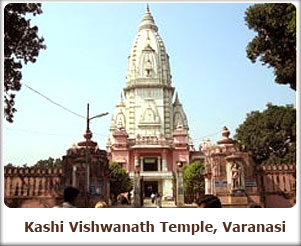 Kashi Vishwanath Mandir: The Vishwanath temple is synonymous to Varanasi. Vishwanath Temple is the most sacred and the most famous temple in Varanasi. In fact, Vishwanath Temple is extremely popular in other parts of India too. A considerable chunk of foreign visitors in India come to Varanasi every year to get a glimpse of the Vishwanath Temple even though the followers of Semitic religions are not allowed to enter the sanctum of the temple.
Kashi Vishwanath Mandir: The Vishwanath temple is synonymous to Varanasi. Vishwanath Temple is the most sacred and the most famous temple in Varanasi. In fact, Vishwanath Temple is extremely popular in other parts of India too. A considerable chunk of foreign visitors in India come to Varanasi every year to get a glimpse of the Vishwanath Temple even though the followers of Semitic religions are not allowed to enter the sanctum of the temple.
Tulsi Manas Mandir: Tulsi Manas Temple has a very historical as well as cultural importance for not only Varanasi but also for the whole of India. This is because Ramayana was composed at this very place. Goswami Tulsi Das was the man who composed Ramayana in Hindi in the form of "Ram Charit Manas".
Visit Sarnath ‑ 5 miles out of Varanasi: The great Buddha enhanced the sanctity of Varanasi by choosing the environs of the city to preach his first sermon at Sarnath, (only 10 Kms away) after attaining enlightenment. Later, Ashoka, the great Mauryan Emperor erected magnificent stupas and other buildings along with his mighty stone pillar, Dharmarajika Stupa. The 110 ft. tall Damekh Stupa marks the place where Buddha preached first sermon. Sarnath has been a premier centre for Buddhism. It is a rich collection of ancient Buddhist relics and antiques comprising numerous Buddha and Bodhisatva images on display at the Archaeological Museum (1000 hrs to 1700 hrs. Open all days except Friday)
Overnight will be at Varanasi.
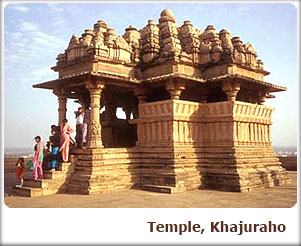 Day 05
Day 05
Varanasi – Khajuraho:
By Air
Breakfast will be at the hotel.
Proceed to the airport for flight to Khajuraho. Reach and check into the hotel.
Khajuraho, which has lent its name to a complex of exquisite Hindu and Jain temples, is a small town located amidst the forested plains of Bundelkhand in north-central Madhya Pradesh. The beautiful temples that dot Khajuraho are believed to have been built by the mighty Chandela rulers in the 9th and 10th century AD. The engravings on these temples are highly sensual and erotic that depicts in graceful forms intimate scenes of the whole range of human emotions and relationships. These sculptures congeal in stone a lyrical paean to love and passion and reflect the Chandela dynasty/’s immense appreciation for art.
Architecturally, the temples are built in the north Indian Nagara style. The sculptor/’s fine skill and a sense of imagination have given form to human emotion in the form of spiritual and physical love. Every façade—wall, window, pillar, and ceiling—is carved with figures of mythical and historical origins, and while many of these depict full-breasted, girdle-waisted women in forms of innocent play, they also depict carnal love.
Khajuraho combines history, architecture, culture and environment with delectable charm. It is a town that takes you away from the noise and pollution of the city, with its fresh air and scenic countryside. For convenience, the temples of Khajuraho are divided into the Western, Eastern, and Southern groups. The Western Group, situated opposite the Government of India Tourist Office, has 14 temples. The Chaunsath Yogini, Lalguan Mahadev, Parvati, Varaha, Matangesvara, Lakshmana, Vishvanath and Nandi, Chitragupta, Devi Jagdamba and Kandariya Mahadeo temples belong to this group. The Eastern Group, 2.4 km from the Tourist Office, consists of seven temples (four Jain and three Hindu). The Parsvanath, Adinath, Shantinath, and Ghantai temples belong to the Jains while the Vamana, Javari and Brahma are Hindu temples. The Southern Group, about 5 km from Khajuraho, contains the Chaturbhuj and Duladeo temples.
Visit the WESTERN SET OF TEMPLES.
Enjoy the Light and Sound show in the evening.
Overnight will be at Khajuraho.
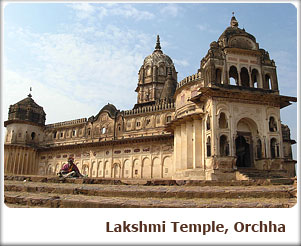 Day 06
Day 06
Khajuraho – Orchha - Jhansi;
By Road 175Kms/04hrs
Jhansi – Gwalior:
By Deluxe train
Enjoy breakfast at the hotel.
Visit the EASTERN SET OF TEMPLES.
Drive to Jhansi railway station visiting Orchha enroute.
ORCHHA - The grandeur and opulence of the former Bundela dynasty is well reflected in Orchha set amidst the flat Bundelkhand countryside. Built by Raja Rudra Pratap on an artificial island on Betwa river, Orchha (17 Km from Jhansi) takes you back to a royal era when Bundela rulers enjoyed the finer things of life cocooned in the comforts of their citadel. Orchha is a photographer's delight. With its forts, regal palaces, striking temples and chattris, it narrates a beautiful medieval tale.
Transfer to JHANSI station after early lunch for SUPERFAST SHATABDI EXPRESS to Gwalior. Reach Gwalior and check in at hotel.
Located at a strategic site, in the Grid region of Northern India, Gwalior is a celebrated city of Madhya Pradesh. With its white sandstone mosques, studded temples and soaring buttresses, the place recounts the majesty of the Indian soil. A chronicler of the rise and fall of many dynasties, the place still retains its antique vaudeville in its art and architecture. Tourists from all over the world trot to the place to get a glimpse of its fine enmeshing of antiquity and modernity. Boasting of a rich historical saga, Gwalior is one of the most prominent tourist destinations in Central India. This article will help you explore the various places of tourist interest to be seen in Gwalior.
Overnight will be at Gwalior.
Day 07
Gwalior:
 Proceed for a sightseeing tour of the city visiting the following interesting monuments after leisurely breakfast.
Proceed for a sightseeing tour of the city visiting the following interesting monuments after leisurely breakfast.
Gwalior Fort: Positioned at a height of 100m above the main town of Gwalior, this staggering citadel dominates the skyline of the place and is acknowledged as the most impregnable fort in the whole of Central and Northern India. Built by Raja Man Singh Tomar, in the 15th century, its beauty has earned it the epithet of "The Pearl amongst Fortresses of India" by the Mughal ruler 'Babur'. The fort is girdled by sandstone walls and stretches over an area of 3 sq km. It houses three temples, six palaces and a large number of water tanks.
Man Mandir: This exquisite architectural specimen was also built by Raja Man Singh Tomar, between 1486 and 1517. Though, most of the ornamentations of this mammoth edifice have been corroded with time, traces of elaborate architectural trimmings and patterns still testify its glorious past. With decorative and colorful friezes and ornate rooms and stone screens, it exhibits a tasteful use of color, motif and patterns. The place houses the 'Suraj Kund Pond', where King Suraj Sen is believed to have been cured by sage Gwalipa.
Teli-ka-Mandir: This ancient edifice is a Pratihara Vishnu temple. Built in the 9th century AD, it towers at a height of 100ft. According to legends, the temple is so named as it is believed to be fabricated in the 'Telangana' architectural style. However, others believe that it is named after the 'Telis' (oil merchants) who built it. The structure displays a unique architectural pattern, with fine blend of Dravidian and Indo-Aryan characteristics. The roof of the temple is distinctly Dravidian, whereas the festoons and adornments have a strong Indo-Aryan appeal.
Saas-Bahu Temple; The Saas-Bahu temple dedicated to Lord Vishnu is also a major landmark of Gwalior. Built in 11th century, the name of the temple can be quite misleading. The temple, as many people believe, is not dedicated to 'Saas' (mother-in-law) and 'Bahu' (daughter-in-law). The name metaphorically and traditionally implies to two temples of different sizes adjoined to each other. The larger is more elaborately patterned with intricate artwork and attractive sculptures. There is also an ornamental lotus adorning its interior roof.
Jai Vilas Palace: Though Jai Vilas Palace is the current residence of the Scindia family; 35 of its palatial rooms have been converted into the 'Scindia Museum'. The architectural style of this imperial structure is dominantly Italian, with a fine blend of Corinthian and Tuscan architectural modes. Handpicked royal treasures and historical artifacts from different countries are displayed in the museum. The most striking one is a silver train, with cut-glass wagons and miniature rails, which chugged along dinner tables and was used to serve food to the guests.
Tomb of Tansen: The father of Hindustani classical music and one of the nine jewels of Akbar's court, legendary singer Tansen is buried in Gwalior. Built in the early style of Mughal architecture, the tomb of Tansen has a simple and pristine aura about it. The headstone is surrounded by beautiful gardens on all its sides. Apart from being an ancient monument, the site also underlines the rich cultural heritage of Gwalior. Every year in the month of November/ December, a national level music competition is held at the place, to venerate this great musician.
Mausoleum of Ghaus Mohammed; Located in the old town of Hazira is the mausoleum of Ghaus Mohammed, the 'Afghan Prince turned Sufi Saint' who helped Babur in annexing the Gwalior Fort. Built in the 16th century, this sandstone tomb is an exemplary piece of Mughal architectural adroitness. Built opulently in early Mughal lines, the screens of the monument have been carved using the pierced stone technique. Thus, these fine trellises look like delicate and exquisitely patterned laces. The beauty of the monument is also enhanced by the dappling gardens that surround it.
Overnight will be at Gwalior.
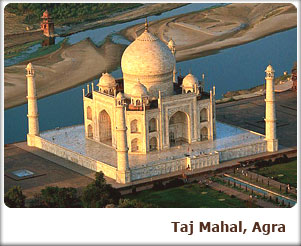 Day 08
Day 08
Gwalior - Agra:
By Road 125Kms/02hrs
After breakfast proceed to Agra. Reach and check into the hotel.
AGRA: Two great Mughal monarchs, Akbar and Shah Jahan, transformed the little village of Agra into a befitting second capital of the Mughal Empire – giving it the name Dar-ul-Khilafat {seat of the Emperor}. Today a visitor to Agra is caught up in a world of contrasting edifices, of red sandstone and white marble, narrow galleys and quaint buggies, and that irresistible charm that this favorite city of the Mughals still retains. It is not surprising, that modern Agra still reflects its Mughal heritage most conspicuously. A walk down the narrow bustling streets of the city will introduce the visitor to the wafting aroma of Mughlai cuisine.
Relax and then proceed for day sightseeing of Agra.
THE TAJ MAHAL – AN EMPEROR’S LAMENT: Agra is the city of the Taj Mahal. It is a sublime experience of the greatest love story ever told. Today India's most fascinating and beautiful masterpiece, this perfectly symmetrical edifice is set amidst landscaped gardens on the banks of the Yamuna River. The Taj was built by the Mughal Emperor Shahjahan as a memorial to his wife, Mumtaz Mahal. After her untimely death, Shah Jahan had her mortal remains buried in this mausoleum. And after his own demise he was placed to rest next to his beloved queen in the same mausoleum. Under the dome, below the ground level, in a dimly lit chamber, lie the mortal remains of Shahjahan and his beloved queen Mumtaz, reminding the world of their undying love. The Taj remains closed for visitors on Friday
AGRA FORT – ARCHITECTURAL WONDER IN STONE: Within a radius of 3 kilometers, on the banks of the river Yamuna raises the crescent like Agra Fort. Designed and built by Akbar in 1565 A.D., the fort is surrounded by a 70 feet high wall. It houses the beautiful Pearl Mosque and numerous palaces including the Jahangir Mahal, Diwan-i-Khas, Diwan-i-Am and Moti Masjid. Later it was used by his son Jahangir also as the seat of power. Shahjahan modeled his creation, the Red Fort at Delhi on this fort. The Agra fort happens to be on the same bank of the river Yamuna as the Taj Mahal which is visible in all its beauty from one side of the fort. So very ironically, Shahjahan, a prisoner of his son Aurangzeb in his old age was put in a cell from where he could gaze at the Taj Mahal at a distance, from his cell in the Agra Fort.
The fort has four gates and is enclosed by a double barricaded wall of red sand stone. Many buildings were constructed within the fort of which very few remain till date. One of the most significant ones is the multi storied Jahangir Mahal built by Akbar for his wife Jodha Bai.
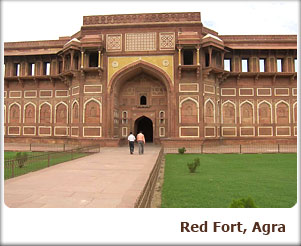 The Mahal is reached through an impressive gateway and its inner courtyard consists of beautiful halls, profuse carvings on stone, exquisitely carved heavy brackets, piers and cross beams.
The Mahal is reached through an impressive gateway and its inner courtyard consists of beautiful halls, profuse carvings on stone, exquisitely carved heavy brackets, piers and cross beams.
SIKANDRA: Sikandra, 10 Kms North West of Agra, is the final resting place of Emperor Akbar. The Tomb of Akbar shows an interesting fusion of Hindu and Mughal architecture reflecting the spirit of the Mughal Emperor Akbar. Akbar began the construction of his own garden mausoleum during his lifetime, a red sandstone structure in a char-Bagh meaning 4-square formal garden.
ITMAD – UL – DAULAH’A TOMB: This tomb was erected by Nur Jahan in sweet memory of her father Ghiasud-Din-Beg between 1622 - 1628 A.D. This white marble structure of the pre-Taj era though smaller is often considered equal if not better to the great one itself.
Overnight will be at Agra.
Day 09
Agra – Fatehpur Sikri - Jaipur:
By Road 265kms/05hrs
Breakfast will be at hotel.
Drive to Jaipur visiting Fatehpur Sikri enroute.
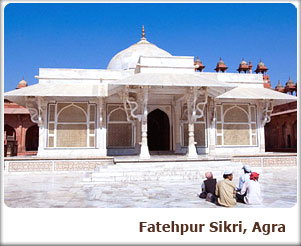 FATEHPUR SIKRI – THE CITY OF VICTORY: 37 Kms from the city of Agra, stands Fatehpur Sikri, Akbar’s capital. Full credit goes to the Archeological Survey of India for this perfectly preserved example of a Mughal city at the height of the empire’s splendor. It is an attraction no visitor to Agra should miss. This sprawling structure is made of red sandstone and combines both Hindu and Mughal architecture. This walled city contains the mausoleum of the Sufi fakir, Saleem Chisti who is said to have granted Akbar and his Hindu queen Jodhabai their wish for a son. The main entrance to Fatehpur Sikri is through the 175 feet Buland Darwaza, the highest gateway in the world. It was built by Akbar to commemorate his victory over Khandesh in Gujarat.
FATEHPUR SIKRI – THE CITY OF VICTORY: 37 Kms from the city of Agra, stands Fatehpur Sikri, Akbar’s capital. Full credit goes to the Archeological Survey of India for this perfectly preserved example of a Mughal city at the height of the empire’s splendor. It is an attraction no visitor to Agra should miss. This sprawling structure is made of red sandstone and combines both Hindu and Mughal architecture. This walled city contains the mausoleum of the Sufi fakir, Saleem Chisti who is said to have granted Akbar and his Hindu queen Jodhabai their wish for a son. The main entrance to Fatehpur Sikri is through the 175 feet Buland Darwaza, the highest gateway in the world. It was built by Akbar to commemorate his victory over Khandesh in Gujarat.
The Panch Mahal is a five-storeyed tower, the highest point in Fatehpur Sikri. This extremely airy tower is supposed to have been used by one of the emperor's many queens.
After lunch continue drive to beautiful Pink City – Jaipur. Reach and check in at hotel.
Jaipur is the capital of the state of Rajasthan a romantic realm of resplendent palaces, mighty fortresses and regal Maharajahs that lies in the western deserts and is an utterly unique part of India. Proudly belonging to the KSHATRIYA warrior caste and fiercely independent, the Rajput princes made fearsome foes. However, many of them realized that to maintain their wealth and authority locally, it was expedient to proclaim allegiance to the central power. Thus, many enjoyed a privileged position under the Mughal emperors and also the British Raj that followed.
The bustling Rajasthan capital of Jaipur takes its name from its venerated founder Jai Singh II, who was given the title Sawai Maharaja by the Mughal. Literally translated this would mean ’one and a quarter’, suggesting that the Mughal thought this emperor to be more valuable than just ‘one’. Jaipur is known as the ’Pink City’ on account of the distinctive colour of its buildings. This did not, however, form part of the original plan, but dates back to 1856, when the city was given a wash of pink in honor of a State Visit from Prince Albert.
This evening, visit the Birla Temple to learn more about the fascinating religious life of Jaipur. The marble structure, built as recently as 1985, houses ornate statues including one of Lakshmi (goddess of Wealth and Beauty) and Narayan dressed in gaudy robes, representing a Hindu vision of heavenly luxury. Carvings in the temple and on pillars supporting the covered walkways include images of the Hindu pantheon, as well as Jesus, the Blessed Virgin Mary and St Francis of Assisi. Your visit will coincide with the AARTI Ceremony, which involves oil lamps being lit and waved, in order to awake and invoke the deity.
Enjoy the experience and spend night at Jaipur.
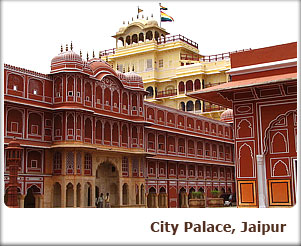 Day 10
Day 10
Jaipur:
After breakfast drive to Amber Palace. Enjoy Elephant Back ascent to the Fort.
AMER PALACE & FORT: Amer Fort and Palace was originally built by Raja Man Singh and subsequently developed by Sawai Jai Singh. The major attractions are Sheela Devi Temple, Sheesh Mahal (Hall of mirrors), Jai Garh Fort a few kilometers from the city centre was built for the defence of the town and has one of the world’s biggest cannons on wheels and a rich collection of arms and weapons.
Continue city sightseeing.
HAWA MAHAL (PALACE OF WINDS): Hawa Mahal is the most strikingly designed monument in Jaipur. Built by the Poet-King Sawai Pratap Singh in 1799, the Hawa Mahal is centrally located and is multiniched five storey high back view of the compled. It was conceived to provide an adequate vantage position behind delicate stone-carved jali, screens for the palace women to watch the royal processions passing through the Bazar below without being seen by outsiders. The Top of the palace affords a beautiful view of the city. A small archaeological museum is yet another attraction in the palace.
JAL MAHAL: The Jal Mahal Palace, Jaipur is noted for its intricate architecture. The Palace was developed as a pleasure spot. It was used for the royal duck shooting parties. On the road to Amber at a distance of 6.5 Kms from Jaipur are the cenotaphs of the royal family. A causeway leads to Jal Mahal Palace situated in the middle of Man Sagar Lake, opposite the cenotaphs. The first four floors of this building is under water, only the top floor remains outside. One can have a wonderful view of the lake and the palace from Nahar Garh Fort Built in 1799, the palace is now abandoned, but reasonably well preserved. In the monsoons, it looks particularly startling with its red sandstone set against the water hyacinth filled lake.
THE CITY PALACE: The city Palace is a historic landmark. The Carved arches are supported by grey-white marble columns studded with floral motifs in gold and colored stones. Two elephants carved in marble, guard the entrance, where retaineers whose families have served generations of the rulers are at hand, to serve as guides.
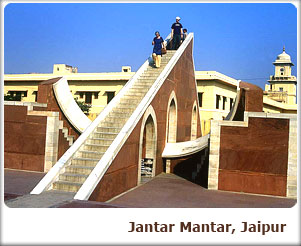 JANTAR MANTAR Jantar Mantar is one of Sawai Jai Singh’s five remarkable observatories. Constructed with stone and marble its compled instruments, whose setting and shapes are precisely and scientifically designed, represent the high-points of medieval Indian Astronomy. The two Ram Yantras used for gauging altitudes are unique in their isolation. This is the largest of five observatories founded by Sawai Jai Singh-II in various parts of the country.
JANTAR MANTAR Jantar Mantar is one of Sawai Jai Singh’s five remarkable observatories. Constructed with stone and marble its compled instruments, whose setting and shapes are precisely and scientifically designed, represent the high-points of medieval Indian Astronomy. The two Ram Yantras used for gauging altitudes are unique in their isolation. This is the largest of five observatories founded by Sawai Jai Singh-II in various parts of the country.
This evening is free for you to relax shop or explore independently. Shopping is superb in Jaipur, particularly for gold and silver jewellery, pottery, tie-dye materials, silk, saris, wooden handicrafts and carpets.
Overnight will be at Jaipur.
Day 11
Jaipur – Delhi:
By Road 260Kms/06hrs
Delhi – Cochin:
By Air
Breakfast will be at hotel.
Drive to Delhi airport to take flight for Cochin. Reach and check into the hotel.
The striking port city of Kochi or Cochin is a tourist's paradise. Lush mangroves, coconut tress reflected in the translucent waters of backwaters, ancient churches, cathedrals and fort - tourists on sightseeing tours of Cochin would find all these and more. Flanked by the Western Ghats on the east and the majestic looking Arabian Sea in the west, Kochi occupies a very strategic location and has been a significant trading zone and attractive tourist destination since time immemorial. The tradition and reputation of this enchantingly quaint port city has maintained till date.
Enjoy Kathakali dance presentation in evening.
Overnight will be at Cochin.
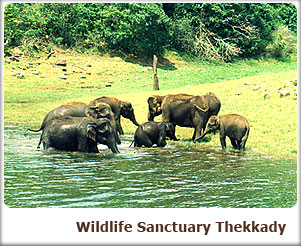 Day 12
Day 12
Cochin – Thekkady:
By Road 190Kms/05hrs
Breakfast will be at hotel.
Proceed to Thekkady. Reach and check into the hotel.
Discover the veritable essence of Kerala’s well kept wilderness secrets at Thekkady. This green oasis is one of the last safe havens for the elusive Indian tiger- an endangered species now on the verge of extinction. This exotic land reminds of a colorful impressionistic painting stirred to life as if by a miracle. Thekkady’s fantabulous landscape is diffused with exotic spice plantations, green carpets of endless tea gardens and lush tropical forests. Garbed in vibrant hues and bountiful gifts of nature, Thekkady offers a perfect romantic escapade into the soothing laps of Mother Nature.
Thekkady is home to the Periyar Tiger Reserve, one of the best among the 27 tiger reserves in India. The very name of this romantic land conjures up exotic visions of wildlife, plantations, spice scented air, crystal clear lakes and mist covered endless rolling hills. Thekkady epitomizes Kerala’s sublime beauty in all its pristine glory. Come and be overwhelmed with a vacation of your lifetime in this dazzling land of impeccable beauty. Each day in this exotic land is a celebration of life and nature; epitomizing “La Dolce Vita”.
Relax and then enjoy the sightseeing.
Kumily: The quaint town of Kumily lies at a distance of about 4 km from Thekkady nestled in the realms of the majestic Cardamom Hills. The plantation town is surrounded by tea and spice plantations making it an ideal place to study how Indian spices are grown and how they are used in local cuisines. The scenic beauty of the area is further accentuated by its crisp blue skies, lush greenery and mist drenched mountains. This hub of spice trade is located at the vicinity of the Periyar wildlife sanctuary and makes a perfect base to explore the region.
Plantation tours: Do make it a point to visit some of the numerous tea and spice plantations in the area. This is the best way to understand how these exotic spices are grown and to learn how they are used in the local cuisines. Tea factories could also be visited to see how the tea leaves are processed and to meet some of the workers involved in it. There are vanilla, cardamom and spice plantations in the region which could be visited with permission.
Enjoy elephant ride.
Overnight will be at Thekkady.
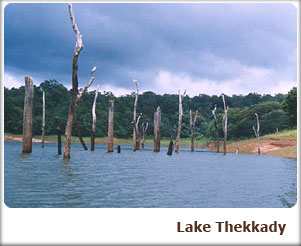 Day 13
Day 13
Thekkady:
Breakfast will be at the hotel.
Today you will visit the rare species of plants and animals by taking a short walk and enjoying the safari.
Periyar Tiger trail: A trekking expedition could be organized inside the Periyar Wildlife Sanctuary with the permission of the authorities. There is a set limit to the maximum number of people per expedition and it’s also subjected to meeting certain medical standards. This is because of the strenuous nature of this expedition through the dense remote jungles. The guides for this trail were poachers earlier and are now actively involved in protecting the unique ecosystem and the wildlife of the region.
Trekking and Mountaineering: Trekking is the best way to explore the scenic beauty of the mountainous terrain. Trekking expeditions could be undertaken at the Periyar Wildlife Sanctuary provided you take prior permission from the authorities. You have to take a guide approved by the authorities before you can go trekking inside the jungles.
Bamboo Rafting: This exciting adventure sport is available at the Periyar Wildlife Sanctuary. You can get in touch with the forest authorities for permission to do bamboo rafting in the Periyar Lake. This is one of the best ways to experience the area and to catch glimpses of wildlife at close quarters.
Overnight will be at Thekkady
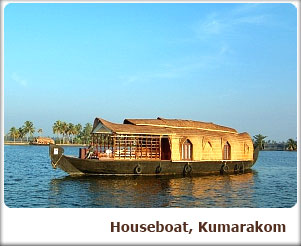 Day 14
Day 14
Thekkady – Kumarakom:
By Road 120Kms/04hrs
After breakfast proceed to Kumarakom.
Kumarakom, a prime backwater-tour destination, is world– renowned for its bewitching backwaters and picturesque tropical landscapes. This naturally blessed land has loads to offer even for the most discerning traveler. The unique geographical terrain of the region dispersed with vast paddy fields, palm groves, mangrove forests, lagoons, canals and backwaters make Kumarakom quite distinct from any other place in Kerala. Life in this small hamlet revolves around the Vembanad Lake – the life-line of Kumarakom; people here lead a unique water-based lifestyle quite different from the rest of the state.
Check into a traditional houseboat of Kerala Style and go on a leisurely backwater cruise along the lake on a thatched houseboat. The houseboat with all modern comforts lets you discover the countryside at your own pace. You will have lunch, dinner and breakfast in the Houseboat. A ride on the houseboat is a fabulous way to explore the fascinating beauty of the backwaters.
Cruise through the backwaters towards Alleppey. Lunch will be served on the boat. The menu is simple and traditional. The cook (chef) of the boat prepares the lunch from fresh materials and even you can have a peek at the recipe.
Tea and snacks would be served in the evening. The boat will be anchored in the backwaters along a paddy field and you can go for a stroll into the village or relax at the deck of the boat.
Dinner will be on the boat. Overnight will be at Houseboat.
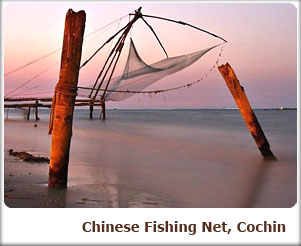 Day 15
Day 15
Alleppey – Cochin:
By Road 50Kms/02hrs
Breakfast will be on board the boat.
Cruise through the backwaters watching the children going to school and the village markets opening.
Disembark the boat at the finishing point where your driver will be waiting for you to drive to COCHIN. Reach and check into the hotel.
Relax & proceed for the sightseeing.
Fort Kochi: Even a casual stroll through Fort Kochi located in the port city of Kochi in Kerala is enough to make you feel transported to another world and time. The architectural style of the buildings and the town layout easily make Fort Cochin distinct from other cities and towns of Kerala. Since Fort Cochin was under the possession of the Portuguese, the Dutch and the British at different points of time, the region still bear the influence of European architecture.
Bolghatty Palace: The splendid Bolghatty Palace is located on the Bolghatty Islands, in the Cochin city of Kerala. The appeal of the palace lies in the fact that it is among the oldest existing palaces built by the Dutch in India, during the pre-British times.
Chinese Fishing Nets: The Chinese fishing nets at Fort Kochi, located in the Kochi city of Kerala, make up a very popular tourist attraction. They are fixed land installations, which are used for a very unique and unusual method of fishing.
Mattancherry Palace: Even though it is austere in its appearance, the Mattancherry Palace of Cochin has a quaint charm of its own. The credit for building this landmark monument partly goes to the Dutch, who captured Cochin city of Kerala during the pre-British period.
Marine Drive: Marine Drive is a beautiful promenade in Kochi (Cochin), Kerala state of India. The Marine Drive is built facing the backwaters of Kochi. It is a popular hangout for the local populace as well as the tourists.
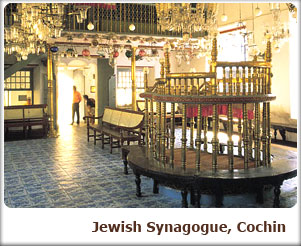 Jewish Synagogue: The Jewish Synagogue in the port city of Kochi is the oldest synagogue in all the Commonwealth of Nations. Thus, it comprises the topmost slot in the itinerary of the tourists visiting the city.
Jewish Synagogue: The Jewish Synagogue in the port city of Kochi is the oldest synagogue in all the Commonwealth of Nations. Thus, it comprises the topmost slot in the itinerary of the tourists visiting the city.
Pareekshith Thampuran Museum: Pareekshith Thampuran Museum is a very good archeological museum located near the Shiva temple, on the Durbar Hall Road at Ernakulam. This museum boasts of an impressive collection of 19th century paintings, ancient monuments and coins, scriptures made in stone and Plaster of Paris, murals as well as memorabilia belonging to the Cochin royal family.
St Francis Church: St Francis Xavier's Church at Fort Kochi was built in the year 1503, by the Portuguese traders. They came here with Admiral Pedro Alvarez de Cabral, via the same route taken by the legendary Portuguese explorer Vasco da Gama, who landed at Calicut in 1498.
Willingdon Island: The Willington Island contains the modern port serving Cochin city of Kerala. The island is an artificial man-made island created from the sand dug out while deepening Kochi port.
Museum of Kerala History: Do not take the Museum of Kerala History in the Cochin city of Kerala as any ordinary museum. The significance of this 'live' museum lies in the fact that it recounts the history of the land through magnificent and informative light and sound shows.
Enjoy Harbour cruise in evening.
Overnight will be at Cochin.
Day 16
Cochin – Departure:
Breakfast will be at the hotel.
Enjoy last minute shopping.
As per the flight timings you will be transferred to the airport to take flight back home with sweet memories of CLASSICAL INDIA & BACKWATERS TOUR.
...........................................................................TOUR ENDS...........................................................................
INCLUSIONS:
Delhi Arrival:
COMPANY REPRESENTATIVE will receive you on arrival at the DELHI AIRPORT and transfer to your hotel.
DELHI, the capital of kingdoms and empires is now a sprawling metropolis with a fascinating blend of the past and the present. It is a perfect introduction to the composite culture of an ancient land. A window to the kaleidoscope - that is India.
Overnight will be at Delhi.
 Day 02
Day 02 Delhi:
After breakfast proceed for a day sightseeing tour of the city.
The city is dotted with historic monuments that are the most popular tourist attractions in Delhi. Apart from the monuments, there are museums, markets, gardens and eating joints that you can visit on your tour of Delhi. Some of the important sightseeing places in Delhi are given below.
INDIA GATE: It is the war memorial dedicated to Indian soldiers, who died during World War I. The name of many soldiers who died during World War I is inscribed on its wall. Edward Lutyens, the man who planned and built New Delhi, designed India Gate. Almost every foreign tourist visits the monument. 'Amar Jawan Jyoti', the eternal flame is added later. The eternal flame runs on gas and is a tribute to soldiers who lost their lives in the service of the nation.
RED FORT: Located in Old Delhi, the Red Fort or Lal Quila is a popular tourist attraction in Delhi. The fort was built by the Mughal emperor Shah Jahan in 1648, when he moved his capital from Agra to Delhi. The construction of the Fort started in 1638 and it was completed 10 years later in 1648. Some of the important spots inside the Red Fort include royal baths or Shahi hamams, Shahi Burj, Moti Masjid or the Pearl Mosque, Diwan-e-Aam and Diwan-e-Khas.
JAMA MASJID: The largest mosque in India, the Jama Masjid was built by Shah Jahan 1656 AD. About 5,000 laborers and craftsmen worked for six years to complete the monument. The mosque can accommodate about 25,000 people. The mosque is located in the old Delhi. The domes are built in white marble. The prayer hall of the mosque has 260 pillars.
OLD FORT: Old Fort or Purana Quila as it is called is located near Pragati Maidan on the Mathura Road. You can club a visit to the Old Fort with your tour of Red Fort and Jama Masjid as the three monuments are located in Old Delhi and are not too far from one another. Humanyun’s started the construction of the fort in 1533 AD, but before the completion of the fort, Sher Shah Suri defeated him and captured Delhi. Sher Shah Suri completed the fort and named it -Shergah. He added many structures to the fort, of which Qila-I-Kuhna Mosque and Sher Mandal are worth mentioning. In 1555, Humanyun’s re-captured Delhi and converted Sher Mandal into a library.
HUMANYUN’S TOMB: Humanyun’s Tomb is mausoleum of the Mughal emperor Humanyun’s. Bega Begum also known as Haji Begum, wife of Humayun constructed the mausoleum for her husband. The tomb was built between 1562 and 1572 AD. The tomb was designed by Mirak Mirza Ghiyuth.
QUTAB MINAR: The construction of the Qutab Minar was stated by Qutub-ud-din Aibak in 1199 AD but he died before completing it. His son-in-law and successor Iltutmish completed the construction of the building. Qutab Minar is located in Meharauli.
LOTUS TEMPLE: Also known as the Bahai Temple, the monument was opened to public only in 1986. Located near Nehru Place, the Lotus Temple is designed like a lotus flower. If you are looking for some moments of peace and tranquility in the crowded city, Lotus Temple is the ideal place to visit.
Apart from the above-mentioned sightseeing options, there are various other tourist attractions that you can visit on your tour of Delhi. Some other sightseeing places in Delhi include Lodi Gardens, National Museum, Jantar Mantar, Dilli Haat and the Garden of Five Senses.
Overnight will be at Delhi.
 Day 03
Day 03 Delhi – Varanasi:
By Air
Breakfast will be at hotel.
Transfer in time to airport for flight to Varanasi. Upon arrival at Varanasi, you will be met and transferred to hotel.
Picturesquely situated on the crescent shaped left bank of the holy River Ganges, Varanasi, one of the ancient seats of learning in India, is said to be a compound of the names of two streams, the Varuna and the Assi, which still flow in the north and south of the city respectively. This name seems to have been corrupted, in medieval times to Varanasi, which was in use till May 1956, when it was changed to Varanasi, by an order of the Government of India. Varanasi is probably one of the most ancient living cities in India. From time immemorial it has been a great religious center for Hindus and one of their most sacred places of pilgrimage, being visited by millions of people every year. To every visitor Varanasi offers a breathtaking experience. The rays of the dawn shimmering across the Ganges; the high-banks; the temples and shrines along the banks bathed in a golden hue …soul stirring hymns and mantras along with the fragrance of incense filling the air…and the refreshing dip in the holy waters gently splashing at the Ghats. Varanasi – The land where experience and discovery reach the ultimate bliss. Varanasi is also renowned for its rich tapestry of music, arts, crafts and education. Some of the world – renowned exponents India has produced in these fields were schooled in Varanasi’s cultural ethos. Luminaries apart, Varanasi abounds in the art of silk weaving, an exotic work of art which manifests itself in precious Banarasi silk sarees and silk brocades which are cherished as collector’s items across the world today.
Enjoy the evening AARTI at the GHATS. The guide will be giving a commentary to you on the proceedings and meanings of the chants during the AARTI of the river.
Later spend the evening shopping in the lanes of Varanasi.
Overnight will be at Varanasi.
 Day 04
Day 04 Varanasi:
Proceed in the morning to Daswamedh Ghat and take a boat ride on the sacred river Ganges to see the cremation Ghats and witness the living traditions of one of the world's oldest and most important religions.
Cruise the Ganges. Perhaps the best way to enjoy the site of Varanasi’s Ghats is a cruise along the river at dawn. Hundreds of bathers, worshippers performing religious rites, holy men practicing yoga and people washing clothes gather at the river’s banks. (To start at 0500 hrs. for the best lifetime experience) For you to appreciate this remarkable city, we’ll transfer you to the banks of the River Ganges before the sun rises. Board a boat with your guide and proceed to the middle of the river, where at sunrise the sight unfolds before you. Thousands of faithful come daily to the banks to bathe and pray while in the background, temples and palaces rise in tiers from the water’s edge. Return for a walk through the cobblestone streets along the banks of "Ganga". As shops are opening, the place now becomes a beehive of activity as the faithful are coming and going.
Return to hotel for a sumptuous breakfast.
Proceed for the sightseeing.
Bharat Mata Mandir: Bharat Mata Mandir or Bharat Mata Temple is one of its kinds in Varanasi. Contrary to what most of the tourists believe, this temple is not dedicated to any God, Goddess or certain deity for that matter. It is dedicated to the human manifestation of India popularly called Mother India or Bharat Mata in Hindi. The temple was inaugurated by non other than Mahatma Gandhi, The father of the Indian Nation.
Banaras Hindu University: BHU was built in the year 1916-1917 under the special act of parliament passed in the year 1915 named BHU act. The act was passed by the interim parliament that worked under the imperial British government. Mahamna Pundit Madan Mohan Malaviya and Annie Besant did the conceptualization and implementation of this university. Raja of Kashi donated 1350 acres of land for the construction of the sprawling campus.
Durga Mandir: Goddess Durga is a significant manifestation of Parvati, the consort of Lord Shiva. In fact she is said to be Shakti, or the manifestation of Parvati that signifies the female element of Power and harmony in nature. This is precisely because a Bengali Maharani built this temple in the 18th century.
 Kashi Vishwanath Mandir: The Vishwanath temple is synonymous to Varanasi. Vishwanath Temple is the most sacred and the most famous temple in Varanasi. In fact, Vishwanath Temple is extremely popular in other parts of India too. A considerable chunk of foreign visitors in India come to Varanasi every year to get a glimpse of the Vishwanath Temple even though the followers of Semitic religions are not allowed to enter the sanctum of the temple.
Kashi Vishwanath Mandir: The Vishwanath temple is synonymous to Varanasi. Vishwanath Temple is the most sacred and the most famous temple in Varanasi. In fact, Vishwanath Temple is extremely popular in other parts of India too. A considerable chunk of foreign visitors in India come to Varanasi every year to get a glimpse of the Vishwanath Temple even though the followers of Semitic religions are not allowed to enter the sanctum of the temple. Tulsi Manas Mandir: Tulsi Manas Temple has a very historical as well as cultural importance for not only Varanasi but also for the whole of India. This is because Ramayana was composed at this very place. Goswami Tulsi Das was the man who composed Ramayana in Hindi in the form of "Ram Charit Manas".
Visit Sarnath ‑ 5 miles out of Varanasi: The great Buddha enhanced the sanctity of Varanasi by choosing the environs of the city to preach his first sermon at Sarnath, (only 10 Kms away) after attaining enlightenment. Later, Ashoka, the great Mauryan Emperor erected magnificent stupas and other buildings along with his mighty stone pillar, Dharmarajika Stupa. The 110 ft. tall Damekh Stupa marks the place where Buddha preached first sermon. Sarnath has been a premier centre for Buddhism. It is a rich collection of ancient Buddhist relics and antiques comprising numerous Buddha and Bodhisatva images on display at the Archaeological Museum (1000 hrs to 1700 hrs. Open all days except Friday)
Overnight will be at Varanasi.
 Day 05
Day 05 Varanasi – Khajuraho:
By Air
Breakfast will be at the hotel.
Proceed to the airport for flight to Khajuraho. Reach and check into the hotel.
Khajuraho, which has lent its name to a complex of exquisite Hindu and Jain temples, is a small town located amidst the forested plains of Bundelkhand in north-central Madhya Pradesh. The beautiful temples that dot Khajuraho are believed to have been built by the mighty Chandela rulers in the 9th and 10th century AD. The engravings on these temples are highly sensual and erotic that depicts in graceful forms intimate scenes of the whole range of human emotions and relationships. These sculptures congeal in stone a lyrical paean to love and passion and reflect the Chandela dynasty/’s immense appreciation for art.
Architecturally, the temples are built in the north Indian Nagara style. The sculptor/’s fine skill and a sense of imagination have given form to human emotion in the form of spiritual and physical love. Every façade—wall, window, pillar, and ceiling—is carved with figures of mythical and historical origins, and while many of these depict full-breasted, girdle-waisted women in forms of innocent play, they also depict carnal love.
Khajuraho combines history, architecture, culture and environment with delectable charm. It is a town that takes you away from the noise and pollution of the city, with its fresh air and scenic countryside. For convenience, the temples of Khajuraho are divided into the Western, Eastern, and Southern groups. The Western Group, situated opposite the Government of India Tourist Office, has 14 temples. The Chaunsath Yogini, Lalguan Mahadev, Parvati, Varaha, Matangesvara, Lakshmana, Vishvanath and Nandi, Chitragupta, Devi Jagdamba and Kandariya Mahadeo temples belong to this group. The Eastern Group, 2.4 km from the Tourist Office, consists of seven temples (four Jain and three Hindu). The Parsvanath, Adinath, Shantinath, and Ghantai temples belong to the Jains while the Vamana, Javari and Brahma are Hindu temples. The Southern Group, about 5 km from Khajuraho, contains the Chaturbhuj and Duladeo temples.
Visit the WESTERN SET OF TEMPLES.
Enjoy the Light and Sound show in the evening.
Overnight will be at Khajuraho.
 Day 06
Day 06 Khajuraho – Orchha - Jhansi;
By Road 175Kms/04hrs
Jhansi – Gwalior:
By Deluxe train
Enjoy breakfast at the hotel.
Visit the EASTERN SET OF TEMPLES.
Drive to Jhansi railway station visiting Orchha enroute.
ORCHHA - The grandeur and opulence of the former Bundela dynasty is well reflected in Orchha set amidst the flat Bundelkhand countryside. Built by Raja Rudra Pratap on an artificial island on Betwa river, Orchha (17 Km from Jhansi) takes you back to a royal era when Bundela rulers enjoyed the finer things of life cocooned in the comforts of their citadel. Orchha is a photographer's delight. With its forts, regal palaces, striking temples and chattris, it narrates a beautiful medieval tale.
Transfer to JHANSI station after early lunch for SUPERFAST SHATABDI EXPRESS to Gwalior. Reach Gwalior and check in at hotel.
Located at a strategic site, in the Grid region of Northern India, Gwalior is a celebrated city of Madhya Pradesh. With its white sandstone mosques, studded temples and soaring buttresses, the place recounts the majesty of the Indian soil. A chronicler of the rise and fall of many dynasties, the place still retains its antique vaudeville in its art and architecture. Tourists from all over the world trot to the place to get a glimpse of its fine enmeshing of antiquity and modernity. Boasting of a rich historical saga, Gwalior is one of the most prominent tourist destinations in Central India. This article will help you explore the various places of tourist interest to be seen in Gwalior.
Overnight will be at Gwalior.
Day 07
Gwalior:
 Proceed for a sightseeing tour of the city visiting the following interesting monuments after leisurely breakfast.
Proceed for a sightseeing tour of the city visiting the following interesting monuments after leisurely breakfast.Gwalior Fort: Positioned at a height of 100m above the main town of Gwalior, this staggering citadel dominates the skyline of the place and is acknowledged as the most impregnable fort in the whole of Central and Northern India. Built by Raja Man Singh Tomar, in the 15th century, its beauty has earned it the epithet of "The Pearl amongst Fortresses of India" by the Mughal ruler 'Babur'. The fort is girdled by sandstone walls and stretches over an area of 3 sq km. It houses three temples, six palaces and a large number of water tanks.
Man Mandir: This exquisite architectural specimen was also built by Raja Man Singh Tomar, between 1486 and 1517. Though, most of the ornamentations of this mammoth edifice have been corroded with time, traces of elaborate architectural trimmings and patterns still testify its glorious past. With decorative and colorful friezes and ornate rooms and stone screens, it exhibits a tasteful use of color, motif and patterns. The place houses the 'Suraj Kund Pond', where King Suraj Sen is believed to have been cured by sage Gwalipa.
Teli-ka-Mandir: This ancient edifice is a Pratihara Vishnu temple. Built in the 9th century AD, it towers at a height of 100ft. According to legends, the temple is so named as it is believed to be fabricated in the 'Telangana' architectural style. However, others believe that it is named after the 'Telis' (oil merchants) who built it. The structure displays a unique architectural pattern, with fine blend of Dravidian and Indo-Aryan characteristics. The roof of the temple is distinctly Dravidian, whereas the festoons and adornments have a strong Indo-Aryan appeal.
Saas-Bahu Temple; The Saas-Bahu temple dedicated to Lord Vishnu is also a major landmark of Gwalior. Built in 11th century, the name of the temple can be quite misleading. The temple, as many people believe, is not dedicated to 'Saas' (mother-in-law) and 'Bahu' (daughter-in-law). The name metaphorically and traditionally implies to two temples of different sizes adjoined to each other. The larger is more elaborately patterned with intricate artwork and attractive sculptures. There is also an ornamental lotus adorning its interior roof.
Jai Vilas Palace: Though Jai Vilas Palace is the current residence of the Scindia family; 35 of its palatial rooms have been converted into the 'Scindia Museum'. The architectural style of this imperial structure is dominantly Italian, with a fine blend of Corinthian and Tuscan architectural modes. Handpicked royal treasures and historical artifacts from different countries are displayed in the museum. The most striking one is a silver train, with cut-glass wagons and miniature rails, which chugged along dinner tables and was used to serve food to the guests.
Tomb of Tansen: The father of Hindustani classical music and one of the nine jewels of Akbar's court, legendary singer Tansen is buried in Gwalior. Built in the early style of Mughal architecture, the tomb of Tansen has a simple and pristine aura about it. The headstone is surrounded by beautiful gardens on all its sides. Apart from being an ancient monument, the site also underlines the rich cultural heritage of Gwalior. Every year in the month of November/ December, a national level music competition is held at the place, to venerate this great musician.
Mausoleum of Ghaus Mohammed; Located in the old town of Hazira is the mausoleum of Ghaus Mohammed, the 'Afghan Prince turned Sufi Saint' who helped Babur in annexing the Gwalior Fort. Built in the 16th century, this sandstone tomb is an exemplary piece of Mughal architectural adroitness. Built opulently in early Mughal lines, the screens of the monument have been carved using the pierced stone technique. Thus, these fine trellises look like delicate and exquisitely patterned laces. The beauty of the monument is also enhanced by the dappling gardens that surround it.
Overnight will be at Gwalior.
 Day 08
Day 08 Gwalior - Agra:
By Road 125Kms/02hrs
After breakfast proceed to Agra. Reach and check into the hotel.
AGRA: Two great Mughal monarchs, Akbar and Shah Jahan, transformed the little village of Agra into a befitting second capital of the Mughal Empire – giving it the name Dar-ul-Khilafat {seat of the Emperor}. Today a visitor to Agra is caught up in a world of contrasting edifices, of red sandstone and white marble, narrow galleys and quaint buggies, and that irresistible charm that this favorite city of the Mughals still retains. It is not surprising, that modern Agra still reflects its Mughal heritage most conspicuously. A walk down the narrow bustling streets of the city will introduce the visitor to the wafting aroma of Mughlai cuisine.
Relax and then proceed for day sightseeing of Agra.
THE TAJ MAHAL – AN EMPEROR’S LAMENT: Agra is the city of the Taj Mahal. It is a sublime experience of the greatest love story ever told. Today India's most fascinating and beautiful masterpiece, this perfectly symmetrical edifice is set amidst landscaped gardens on the banks of the Yamuna River. The Taj was built by the Mughal Emperor Shahjahan as a memorial to his wife, Mumtaz Mahal. After her untimely death, Shah Jahan had her mortal remains buried in this mausoleum. And after his own demise he was placed to rest next to his beloved queen in the same mausoleum. Under the dome, below the ground level, in a dimly lit chamber, lie the mortal remains of Shahjahan and his beloved queen Mumtaz, reminding the world of their undying love. The Taj remains closed for visitors on Friday
AGRA FORT – ARCHITECTURAL WONDER IN STONE: Within a radius of 3 kilometers, on the banks of the river Yamuna raises the crescent like Agra Fort. Designed and built by Akbar in 1565 A.D., the fort is surrounded by a 70 feet high wall. It houses the beautiful Pearl Mosque and numerous palaces including the Jahangir Mahal, Diwan-i-Khas, Diwan-i-Am and Moti Masjid. Later it was used by his son Jahangir also as the seat of power. Shahjahan modeled his creation, the Red Fort at Delhi on this fort. The Agra fort happens to be on the same bank of the river Yamuna as the Taj Mahal which is visible in all its beauty from one side of the fort. So very ironically, Shahjahan, a prisoner of his son Aurangzeb in his old age was put in a cell from where he could gaze at the Taj Mahal at a distance, from his cell in the Agra Fort.
The fort has four gates and is enclosed by a double barricaded wall of red sand stone. Many buildings were constructed within the fort of which very few remain till date. One of the most significant ones is the multi storied Jahangir Mahal built by Akbar for his wife Jodha Bai.
 The Mahal is reached through an impressive gateway and its inner courtyard consists of beautiful halls, profuse carvings on stone, exquisitely carved heavy brackets, piers and cross beams.
The Mahal is reached through an impressive gateway and its inner courtyard consists of beautiful halls, profuse carvings on stone, exquisitely carved heavy brackets, piers and cross beams.SIKANDRA: Sikandra, 10 Kms North West of Agra, is the final resting place of Emperor Akbar. The Tomb of Akbar shows an interesting fusion of Hindu and Mughal architecture reflecting the spirit of the Mughal Emperor Akbar. Akbar began the construction of his own garden mausoleum during his lifetime, a red sandstone structure in a char-Bagh meaning 4-square formal garden.
ITMAD – UL – DAULAH’A TOMB: This tomb was erected by Nur Jahan in sweet memory of her father Ghiasud-Din-Beg between 1622 - 1628 A.D. This white marble structure of the pre-Taj era though smaller is often considered equal if not better to the great one itself.
Overnight will be at Agra.
Day 09
Agra – Fatehpur Sikri - Jaipur:
By Road 265kms/05hrs
Breakfast will be at hotel.
Drive to Jaipur visiting Fatehpur Sikri enroute.
 FATEHPUR SIKRI – THE CITY OF VICTORY: 37 Kms from the city of Agra, stands Fatehpur Sikri, Akbar’s capital. Full credit goes to the Archeological Survey of India for this perfectly preserved example of a Mughal city at the height of the empire’s splendor. It is an attraction no visitor to Agra should miss. This sprawling structure is made of red sandstone and combines both Hindu and Mughal architecture. This walled city contains the mausoleum of the Sufi fakir, Saleem Chisti who is said to have granted Akbar and his Hindu queen Jodhabai their wish for a son. The main entrance to Fatehpur Sikri is through the 175 feet Buland Darwaza, the highest gateway in the world. It was built by Akbar to commemorate his victory over Khandesh in Gujarat.
FATEHPUR SIKRI – THE CITY OF VICTORY: 37 Kms from the city of Agra, stands Fatehpur Sikri, Akbar’s capital. Full credit goes to the Archeological Survey of India for this perfectly preserved example of a Mughal city at the height of the empire’s splendor. It is an attraction no visitor to Agra should miss. This sprawling structure is made of red sandstone and combines both Hindu and Mughal architecture. This walled city contains the mausoleum of the Sufi fakir, Saleem Chisti who is said to have granted Akbar and his Hindu queen Jodhabai their wish for a son. The main entrance to Fatehpur Sikri is through the 175 feet Buland Darwaza, the highest gateway in the world. It was built by Akbar to commemorate his victory over Khandesh in Gujarat.The Panch Mahal is a five-storeyed tower, the highest point in Fatehpur Sikri. This extremely airy tower is supposed to have been used by one of the emperor's many queens.
After lunch continue drive to beautiful Pink City – Jaipur. Reach and check in at hotel.
Jaipur is the capital of the state of Rajasthan a romantic realm of resplendent palaces, mighty fortresses and regal Maharajahs that lies in the western deserts and is an utterly unique part of India. Proudly belonging to the KSHATRIYA warrior caste and fiercely independent, the Rajput princes made fearsome foes. However, many of them realized that to maintain their wealth and authority locally, it was expedient to proclaim allegiance to the central power. Thus, many enjoyed a privileged position under the Mughal emperors and also the British Raj that followed.
The bustling Rajasthan capital of Jaipur takes its name from its venerated founder Jai Singh II, who was given the title Sawai Maharaja by the Mughal. Literally translated this would mean ’one and a quarter’, suggesting that the Mughal thought this emperor to be more valuable than just ‘one’. Jaipur is known as the ’Pink City’ on account of the distinctive colour of its buildings. This did not, however, form part of the original plan, but dates back to 1856, when the city was given a wash of pink in honor of a State Visit from Prince Albert.
This evening, visit the Birla Temple to learn more about the fascinating religious life of Jaipur. The marble structure, built as recently as 1985, houses ornate statues including one of Lakshmi (goddess of Wealth and Beauty) and Narayan dressed in gaudy robes, representing a Hindu vision of heavenly luxury. Carvings in the temple and on pillars supporting the covered walkways include images of the Hindu pantheon, as well as Jesus, the Blessed Virgin Mary and St Francis of Assisi. Your visit will coincide with the AARTI Ceremony, which involves oil lamps being lit and waved, in order to awake and invoke the deity.
Enjoy the experience and spend night at Jaipur.
 Day 10
Day 10 Jaipur:
After breakfast drive to Amber Palace. Enjoy Elephant Back ascent to the Fort.
AMER PALACE & FORT: Amer Fort and Palace was originally built by Raja Man Singh and subsequently developed by Sawai Jai Singh. The major attractions are Sheela Devi Temple, Sheesh Mahal (Hall of mirrors), Jai Garh Fort a few kilometers from the city centre was built for the defence of the town and has one of the world’s biggest cannons on wheels and a rich collection of arms and weapons.
Continue city sightseeing.
HAWA MAHAL (PALACE OF WINDS): Hawa Mahal is the most strikingly designed monument in Jaipur. Built by the Poet-King Sawai Pratap Singh in 1799, the Hawa Mahal is centrally located and is multiniched five storey high back view of the compled. It was conceived to provide an adequate vantage position behind delicate stone-carved jali, screens for the palace women to watch the royal processions passing through the Bazar below without being seen by outsiders. The Top of the palace affords a beautiful view of the city. A small archaeological museum is yet another attraction in the palace.
JAL MAHAL: The Jal Mahal Palace, Jaipur is noted for its intricate architecture. The Palace was developed as a pleasure spot. It was used for the royal duck shooting parties. On the road to Amber at a distance of 6.5 Kms from Jaipur are the cenotaphs of the royal family. A causeway leads to Jal Mahal Palace situated in the middle of Man Sagar Lake, opposite the cenotaphs. The first four floors of this building is under water, only the top floor remains outside. One can have a wonderful view of the lake and the palace from Nahar Garh Fort Built in 1799, the palace is now abandoned, but reasonably well preserved. In the monsoons, it looks particularly startling with its red sandstone set against the water hyacinth filled lake.
THE CITY PALACE: The city Palace is a historic landmark. The Carved arches are supported by grey-white marble columns studded with floral motifs in gold and colored stones. Two elephants carved in marble, guard the entrance, where retaineers whose families have served generations of the rulers are at hand, to serve as guides.
 JANTAR MANTAR Jantar Mantar is one of Sawai Jai Singh’s five remarkable observatories. Constructed with stone and marble its compled instruments, whose setting and shapes are precisely and scientifically designed, represent the high-points of medieval Indian Astronomy. The two Ram Yantras used for gauging altitudes are unique in their isolation. This is the largest of five observatories founded by Sawai Jai Singh-II in various parts of the country.
JANTAR MANTAR Jantar Mantar is one of Sawai Jai Singh’s five remarkable observatories. Constructed with stone and marble its compled instruments, whose setting and shapes are precisely and scientifically designed, represent the high-points of medieval Indian Astronomy. The two Ram Yantras used for gauging altitudes are unique in their isolation. This is the largest of five observatories founded by Sawai Jai Singh-II in various parts of the country.This evening is free for you to relax shop or explore independently. Shopping is superb in Jaipur, particularly for gold and silver jewellery, pottery, tie-dye materials, silk, saris, wooden handicrafts and carpets.
Overnight will be at Jaipur.
Day 11
Jaipur – Delhi:
By Road 260Kms/06hrs
Delhi – Cochin:
By Air
Breakfast will be at hotel.
Drive to Delhi airport to take flight for Cochin. Reach and check into the hotel.
The striking port city of Kochi or Cochin is a tourist's paradise. Lush mangroves, coconut tress reflected in the translucent waters of backwaters, ancient churches, cathedrals and fort - tourists on sightseeing tours of Cochin would find all these and more. Flanked by the Western Ghats on the east and the majestic looking Arabian Sea in the west, Kochi occupies a very strategic location and has been a significant trading zone and attractive tourist destination since time immemorial. The tradition and reputation of this enchantingly quaint port city has maintained till date.
Enjoy Kathakali dance presentation in evening.
Overnight will be at Cochin.
 Day 12
Day 12 Cochin – Thekkady:
By Road 190Kms/05hrs
Breakfast will be at hotel.
Proceed to Thekkady. Reach and check into the hotel.
Discover the veritable essence of Kerala’s well kept wilderness secrets at Thekkady. This green oasis is one of the last safe havens for the elusive Indian tiger- an endangered species now on the verge of extinction. This exotic land reminds of a colorful impressionistic painting stirred to life as if by a miracle. Thekkady’s fantabulous landscape is diffused with exotic spice plantations, green carpets of endless tea gardens and lush tropical forests. Garbed in vibrant hues and bountiful gifts of nature, Thekkady offers a perfect romantic escapade into the soothing laps of Mother Nature.
Thekkady is home to the Periyar Tiger Reserve, one of the best among the 27 tiger reserves in India. The very name of this romantic land conjures up exotic visions of wildlife, plantations, spice scented air, crystal clear lakes and mist covered endless rolling hills. Thekkady epitomizes Kerala’s sublime beauty in all its pristine glory. Come and be overwhelmed with a vacation of your lifetime in this dazzling land of impeccable beauty. Each day in this exotic land is a celebration of life and nature; epitomizing “La Dolce Vita”.
Relax and then enjoy the sightseeing.
Kumily: The quaint town of Kumily lies at a distance of about 4 km from Thekkady nestled in the realms of the majestic Cardamom Hills. The plantation town is surrounded by tea and spice plantations making it an ideal place to study how Indian spices are grown and how they are used in local cuisines. The scenic beauty of the area is further accentuated by its crisp blue skies, lush greenery and mist drenched mountains. This hub of spice trade is located at the vicinity of the Periyar wildlife sanctuary and makes a perfect base to explore the region.
Plantation tours: Do make it a point to visit some of the numerous tea and spice plantations in the area. This is the best way to understand how these exotic spices are grown and to learn how they are used in the local cuisines. Tea factories could also be visited to see how the tea leaves are processed and to meet some of the workers involved in it. There are vanilla, cardamom and spice plantations in the region which could be visited with permission.
Enjoy elephant ride.
Overnight will be at Thekkady.
 Day 13
Day 13 Thekkady:
Breakfast will be at the hotel.
Today you will visit the rare species of plants and animals by taking a short walk and enjoying the safari.
Periyar Tiger trail: A trekking expedition could be organized inside the Periyar Wildlife Sanctuary with the permission of the authorities. There is a set limit to the maximum number of people per expedition and it’s also subjected to meeting certain medical standards. This is because of the strenuous nature of this expedition through the dense remote jungles. The guides for this trail were poachers earlier and are now actively involved in protecting the unique ecosystem and the wildlife of the region.
Trekking and Mountaineering: Trekking is the best way to explore the scenic beauty of the mountainous terrain. Trekking expeditions could be undertaken at the Periyar Wildlife Sanctuary provided you take prior permission from the authorities. You have to take a guide approved by the authorities before you can go trekking inside the jungles.
Bamboo Rafting: This exciting adventure sport is available at the Periyar Wildlife Sanctuary. You can get in touch with the forest authorities for permission to do bamboo rafting in the Periyar Lake. This is one of the best ways to experience the area and to catch glimpses of wildlife at close quarters.
Overnight will be at Thekkady
 Day 14
Day 14 Thekkady – Kumarakom:
By Road 120Kms/04hrs
After breakfast proceed to Kumarakom.
Kumarakom, a prime backwater-tour destination, is world– renowned for its bewitching backwaters and picturesque tropical landscapes. This naturally blessed land has loads to offer even for the most discerning traveler. The unique geographical terrain of the region dispersed with vast paddy fields, palm groves, mangrove forests, lagoons, canals and backwaters make Kumarakom quite distinct from any other place in Kerala. Life in this small hamlet revolves around the Vembanad Lake – the life-line of Kumarakom; people here lead a unique water-based lifestyle quite different from the rest of the state.
Check into a traditional houseboat of Kerala Style and go on a leisurely backwater cruise along the lake on a thatched houseboat. The houseboat with all modern comforts lets you discover the countryside at your own pace. You will have lunch, dinner and breakfast in the Houseboat. A ride on the houseboat is a fabulous way to explore the fascinating beauty of the backwaters.
Cruise through the backwaters towards Alleppey. Lunch will be served on the boat. The menu is simple and traditional. The cook (chef) of the boat prepares the lunch from fresh materials and even you can have a peek at the recipe.
Tea and snacks would be served in the evening. The boat will be anchored in the backwaters along a paddy field and you can go for a stroll into the village or relax at the deck of the boat.
Dinner will be on the boat. Overnight will be at Houseboat.
 Day 15
Day 15 Alleppey – Cochin:
By Road 50Kms/02hrs
Breakfast will be on board the boat.
Cruise through the backwaters watching the children going to school and the village markets opening.
Disembark the boat at the finishing point where your driver will be waiting for you to drive to COCHIN. Reach and check into the hotel.
Relax & proceed for the sightseeing.
Fort Kochi: Even a casual stroll through Fort Kochi located in the port city of Kochi in Kerala is enough to make you feel transported to another world and time. The architectural style of the buildings and the town layout easily make Fort Cochin distinct from other cities and towns of Kerala. Since Fort Cochin was under the possession of the Portuguese, the Dutch and the British at different points of time, the region still bear the influence of European architecture.
Bolghatty Palace: The splendid Bolghatty Palace is located on the Bolghatty Islands, in the Cochin city of Kerala. The appeal of the palace lies in the fact that it is among the oldest existing palaces built by the Dutch in India, during the pre-British times.
Chinese Fishing Nets: The Chinese fishing nets at Fort Kochi, located in the Kochi city of Kerala, make up a very popular tourist attraction. They are fixed land installations, which are used for a very unique and unusual method of fishing.
Mattancherry Palace: Even though it is austere in its appearance, the Mattancherry Palace of Cochin has a quaint charm of its own. The credit for building this landmark monument partly goes to the Dutch, who captured Cochin city of Kerala during the pre-British period.
Marine Drive: Marine Drive is a beautiful promenade in Kochi (Cochin), Kerala state of India. The Marine Drive is built facing the backwaters of Kochi. It is a popular hangout for the local populace as well as the tourists.
 Jewish Synagogue: The Jewish Synagogue in the port city of Kochi is the oldest synagogue in all the Commonwealth of Nations. Thus, it comprises the topmost slot in the itinerary of the tourists visiting the city.
Jewish Synagogue: The Jewish Synagogue in the port city of Kochi is the oldest synagogue in all the Commonwealth of Nations. Thus, it comprises the topmost slot in the itinerary of the tourists visiting the city. Pareekshith Thampuran Museum: Pareekshith Thampuran Museum is a very good archeological museum located near the Shiva temple, on the Durbar Hall Road at Ernakulam. This museum boasts of an impressive collection of 19th century paintings, ancient monuments and coins, scriptures made in stone and Plaster of Paris, murals as well as memorabilia belonging to the Cochin royal family.
St Francis Church: St Francis Xavier's Church at Fort Kochi was built in the year 1503, by the Portuguese traders. They came here with Admiral Pedro Alvarez de Cabral, via the same route taken by the legendary Portuguese explorer Vasco da Gama, who landed at Calicut in 1498.
Willingdon Island: The Willington Island contains the modern port serving Cochin city of Kerala. The island is an artificial man-made island created from the sand dug out while deepening Kochi port.
Museum of Kerala History: Do not take the Museum of Kerala History in the Cochin city of Kerala as any ordinary museum. The significance of this 'live' museum lies in the fact that it recounts the history of the land through magnificent and informative light and sound shows.
Enjoy Harbour cruise in evening.
Overnight will be at Cochin.
Day 16
Cochin – Departure:
Breakfast will be at the hotel.
Enjoy last minute shopping.
As per the flight timings you will be transferred to the airport to take flight back home with sweet memories of CLASSICAL INDIA & BACKWATERS TOUR.
...........................................................................TOUR ENDS...........................................................................
INCLUSIONS:
- ACCOMODATION AT SUGGESTED HOTELS,
- DAILY BUFFET BREAKFASTS,
- AC VEHICLE WITH THE DRIVER FOR ALL TRANSFERS & SIGHTSEEING AS PER THE ITINERARY,
- MEET AND ASSIST AT THE AIRPORT/STATION ON ARRIVAL/DEPARTURE,
- ENGLISH SPEAKING LOCAL GUIDES AT APPLICABLE PLACES
- RICKSHAW RIDE IN DELHI,
- EVENING AARTI AT GHATS OF GANGES- VARANASI,
- VISIT TO SARNATH,
- MORNING BOAT CRUISE AT VARANASI,
- LIGHT AND SOUND SHOW AT KHAJURAHO,
- LUNCH AT ORCHHA,
- TONGA RIDE TO TAJ MAHAL IN AGRA,
- FATEHPUR SIKRI EXCURSION,
- ELEPHANT RIDE AT AMER FORT, JAIPUR,
- KATHAKALI DANCE PRESENTATION AT COCHIN,
- DAY PACKAGE WITH BAMBOO RAFTING IN PERIYAR,
- SPICE PLANTATION TOUR IN PERIYAR,
- ELEPHANT RIDE IN PERIYAR,
- OVERNIGHT STAY IN HOUSEBOAT,
- ALL MEALS IN HOUSEBOAT
- HARBOUR CRUISE AT COCHIN,
- TRAIN FARE IN AC CHAIR CAR FROM JHANSI – GWALIOR,
- AIRFARE IN ECONOMY CLASS FROM DELHI – VARANASI – KHAJURAHO / DELHI - COCHIN,
- TOLL TAXES, DRIVER ALLOWANCE, PARKING, AND
- ALL APPLICABLE TAXES AND SERVICE CHARGES.
- LUNCHES & DINNERS,
- MONUMENT ENTRANCES,
- CAMERA CHARGES AT THE MONUMENTS,
- PORTER CHARGES,
- TIPS &
- PERSONAL EXPENSES.

